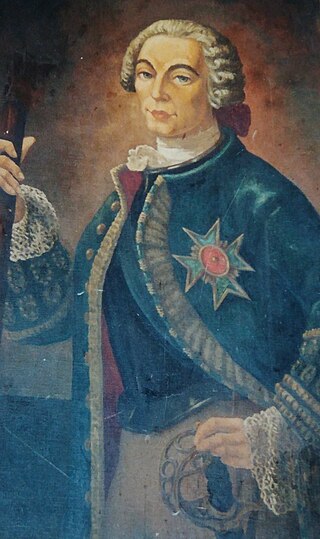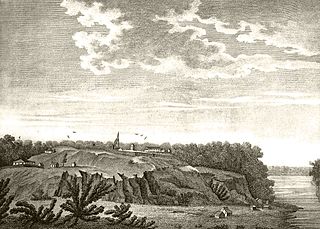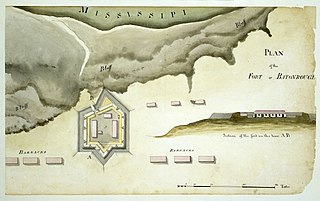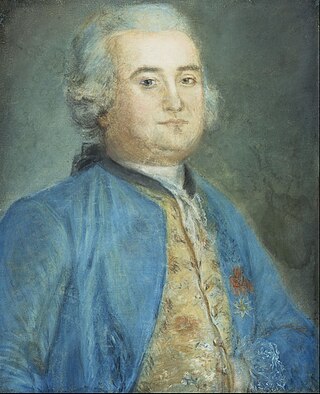Related Research Articles

Bernardo Vicente de Gálvez y Madrid, 1st Count of Gálvez was a Spanish military leader and government official who served as colonial governor of Spanish Louisiana and Cuba, and later as Viceroy of New Spain.

The Natchez District was one of two areas established in the Kingdom of Great Britain's West Florida colony during the 1770s – the other being the Tombigbee District. The first Anglo settlers in the district came primarily from other parts of British America. The district was recognized to be the area east of the Mississippi River from Bayou Sara in the south and Bayou Pierre in the north.

The Capture of Fort Bute signalled the opening of Spanish intervention in the American Revolutionary War on the side of France and the United States. Mustering an ad hoc army of Spanish regulars, Acadian militia, and native levies under Gilbert Antoine de St. Maxent, Bernardo de Gálvez, the Governor of Spanish Louisiana stormed and captured the small British frontier post on Bayou Manchac on September 7, 1779.

The Battle of Baton Rouge was a brief siege during the Anglo-Spanish War that was decided on September 21, 1779. Fort New Richmond was the second British outpost to fall to Spanish arms during Bernardo de Gálvez's march into West Florida.

Étienne Perier or Étienne de Perier (1686–1766), also known as Perier the Elder, was a French naval officer and governor of French Louisiana from 1726 to 1733. His time as governor included some notable achievements, including the construction of the first levee along the Mississippi River in 1727. In response to the Natchez Revolt, he attempted to completely destroy the Natchez people, which increased Native American hostility toward the French in the territory. Because he failed to secure the safety of the colony, Perier was recalled as governor in March 1733. He later distinguished himself as a naval officer and privateer, including during the capture of HMS Northumberland in 1744.

The Gulf Coast campaign or the Spanish conquest of West Florida in the American Revolutionary War, was a series of military operations primarily directed by the governor of Spanish Louisiana, Bernardo de Gálvez, against the British province of West Florida. Begun with operations against British positions on the Mississippi River shortly after Britain and Spain went to war in 1779, Gálvez completed the conquest of West Florida in 1781 with the successful siege of Pensacola.
Oliver Pollock was a merchant and financier of the American Revolutionary War, of which he has long been considered a historically undervalued figure. He is often credited with inventing the U.S. Dollar sign in 1778.
Galvez is an unincorporated community in Ascension Parish, Louisiana, United States, ten miles (16 km) southeast of Baton Rouge. It is surrounded by the larger unincorporated community of Prairieville, with which it shares the 70769 ZIP code.

Feliciana Parish, or New Feliciana, French: Paroisse de Félicianne, was a parish of the Territory of Orleans and the state of Louisiana, formed in 1810 from West Florida territory. Given an increase in population, it was divided in 1824 into East Feliciana Parish and West Feliciana Parish.

Fort Rosalie was built by the French in 1716 within the territory of the Natchez Native Americans as part of the French colonial empire in the present-day city of Natchez, Mississippi.
Bayou Manchac is an 18-mile-long (29 km) bayou in southeast Louisiana, USA. First called the Iberville River by its French discoverers, the bayou was once a very important waterway linking the Mississippi River to the Amite River. East Baton Rouge Parish lies on its northern side, while its southern side is divided between Ascension Parish and Iberville Parish. The large unincorporated community of Prairieville and the city of St. Gabriel both lie on its southern side.

Fort New Richmond was built by the British in 1779 on the east bank of the Mississippi River in what was later to become Baton Rouge, Louisiana. The Spanish took control of the fort in 1779 and renamed it Fort San Carlos.

British West Florida was a colony of the Kingdom of Great Britain from 1763 until 1783, when it was ceded to Spain as part of the Peace of Paris.

The Battle of Lake Pontchartrain was a single-ship action on September 10, 1779, part of the Anglo-Spanish War. It was fought between the British sloop-of-war HMS West Florida and the Continental Navy schooner USS Morris in the waters of Lake Pontchartrain, then in the British province of West Florida.

Francisco Domingo Joseph Bouligny y Paret was a Spanish Army officer and colonial administrator who served as the acting governor of Louisiana in 1799. As a francophone in Spanish service, he was a bridge between Creole and French Louisiana and Spain following the transfer of the territory from France to Spain. Bouligny served as lieutenant governor under Bernardo de Gálvez, founded the city of New Iberia in 1779, and served as acting military governor in 1799 for just one year.
Carlos Louis Boucher De Grand Pré was Spanish governor of the Baton Rouge district (1799–1808), as well as brevet colonel in the Spanish Army. He also served as lieutenant governor of Red River District and of the Natchez District.

Fort Bute (1766–1779) was a colonial fort built by the British in 1766 to protect the confluence of Bayou Manchac with the Mississippi River and was named in honor of the Earl of Bute. Fort Bute was located on Bayou Manchac, about 115 miles (185 km) up the Mississippi River from New Orleans, on the far western border of British West Florida. It was one of the three outposts maintained by the British in the lower Mississippi along with Fort Panmure and the Baton Rouge outpost.
James Willing (1750–1801) was a representative of the American Continental Congress who led a 1778 military expedition during the American Revolutionary War. Known as the Willing Expedition, the effort involved raiding British forts, plantations, and other properties of loyalists in the colonial British West Florida settlement of Natchez. Later that year, he sought protection from the British by hiding out in New Orleans, but was taken prisoner by them on his attempt to return to Philadelphia.
Istrouma is an unincorporated community in East Baton Rouge Parish, Louisiana, United States. The community is located less than 2 miles northwest of Baton Rouge and 7 miles south of Baker.
References
- ↑ James, U.P. (1913). Library of American History. Cincinnati. pp. 382–383.
{{cite book}}: CS1 maint: location missing publisher (link) - ↑ Navy Dept. (U.S.); Naval History & Heritage Command (U.S.) (14 July 2014). Naval Documents of the American Revolution Volume 12, American Theater, April 1, 1778-May 31, 1778; European Theater, April 1, 1778- May 31, 1778. Government Printing Office. pp. 907–. ISBN 978-0-945274-72-8.
- ↑ D. Clayton James (1 May 1993). Lt. Spalding in Civil War Louisiana: A Union Officer's Humor, Privilege, and Ambition. LSU Press. p. 22. ISBN 978-0-8071-1860-3.
- ↑ Rose Meyers (1 March 1999). A History of Baton Rouge, 1699–1812. LSU Press. p. 32. ISBN 978-0-8071-2431-4.
- 1 2 Rose Meyers (1 March 1999). A History of Baton Rouge, 1699–1812. LSU Press. p. 33. ISBN 978-0-8071-2431-4.
- ↑ Charles Rappleye (2 November 2010). Robert Morris: Financier of the American Revolution . Simon and Schuster. p. 141. ISBN 978-1-4165-7286-2.
- ↑ Samuel Flagg Bemis (16 April 2013). The Diplomacy Of The American Revolution. Read Books Limited. p. 94. ISBN 978-1-4474-8515-5.
- 1 2 Rose Meyers (1 March 1999). A History of Baton Rouge, 1699–1812. LSU Press. p. 36. ISBN 978-0-8071-2431-4.